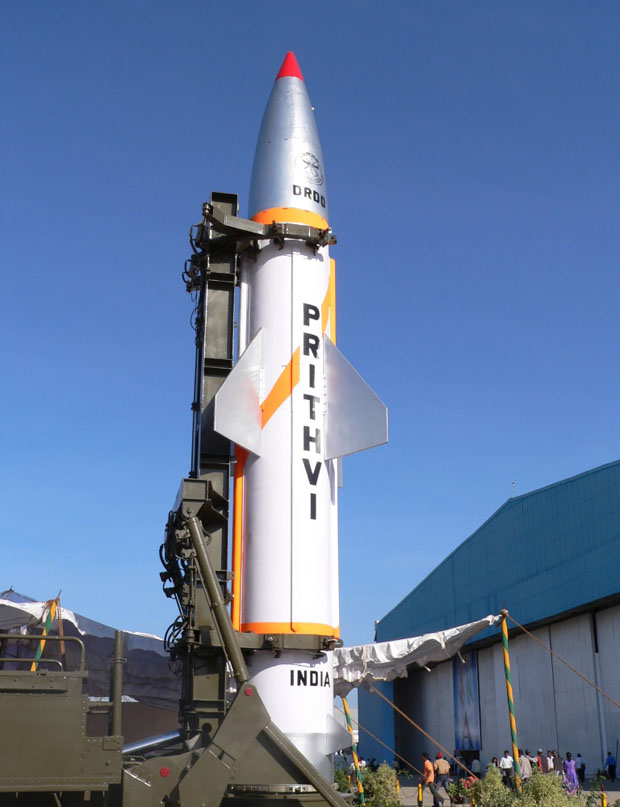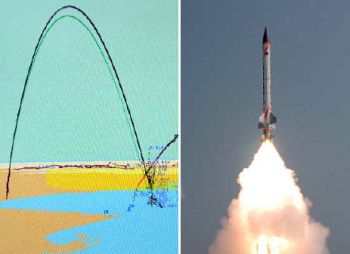인도, 요격미사일 시험발사 성공적으로 마쳐
Slam | 2007-12-08 22:35:04
조회 7524 | 추천 5 | 다운로드 8
인도가 지난 12월6일 오리사주 동쪽 벵골만에서 AAD-02라 명명되는 요격미사일 시험발사를 하여
이동식 발사대에서 발사된 단거리 탄도미사일 Prithvi를 요격하는데 성공하였습니다
AAD-02는 고체연료 방식으로 추진되며 지상에서 30km까지 도달합니다
이번 발사는 15km이내에서 진행되었고 최고 과학자들이 보는 상태에서 진행되었습니다
인도는 이번성공을 바탕으로 하여 IRBM 요격시험에도 나설 계획입니다
Saraswat 미사일통제관에 말에 의하면 PAC-3보다 우수한 성능을 가진다고 하며 내년4월까지
대기권내,외에서 탄도미사일을 격추할 수 있는 미사일을 실전배치할 계획입니다
AAD-02는 길이 7.5m 무게 1.2t 직경이 0.5m인 미사일입니다
India on Thursday test-fired its indigenously designed and developed Advanced Air Defence (AAD) missile, capable of destroying any hostile ballistic missiles at low altitude, from the Integrated Test Range off Orissa's east coast.
Aimed at developing a full fledged multi-layer Ballistic Missile Defence (BMD) system, the test-fire exercise was carried out from two different launch sites of the ITR in the Bay of Bengal, defence sources said.
The target missile, a modified indigenously built Prithvi was first test-fired from a mobile launcher at 1100 hrs from ITR's launch complex-3 at Chandipur-on-sea, while 2 minutes 40 seconds later the interceptor was fired from Wheeler's Island, 70 nautical miles from here, to intercept it at an altitude of 15 km in the mid air.
Though both the launch, conducted successfully, were like 'text book flights', detail results, specifically the 'kill' effects of the interceptor of the co-ordinate exercise will be known after all data analysis from multiple sources, a defence official associated with the test said.
Scientists from the country's premier institute, the Defence Research and Development Organisation (DRDO), have been working on the project for the last couple of years, said the source.
Yet to get a formal name, this new hypersonic interceptor missile is only termed as 'AAD-02' meant to be engaged in 'endo-atmospheric conditions', the source said.
India on November 27, 2006 had successfully tested an 'Exo-atmospheric' interceptor missile, PAD-01 which destroyed an incoming Prithvi missile at an altitude of 50 km and on December two, this year, a solo and mock trial of the present variant, was carried out with an simulated electronic target from the Wheeler's Island.
The seven-meter long AAD interceptor is a single stage solid rocket propelled guided missile, equipped with an inertial navigation system, a hi-tech computer and an electro- mechanical activator totally under command by the data uplinked from the sophisticated ground based radars to the interceptor, sources said.
Though AAD missile is designed to reach an altitude of almost 30 meters above the launch surface, Thursday's trial was conducted within 15 km altitude from it, they added.
The interceptor missile had its own mobile launcher, secure data link for interception, independent tracking and homing capabilities and its own radars.
The trial was conducted in the presence of top defence scientists including V K Saraswat, Chief Controller of DRDO's research and development (missile and strategic systems), they said.
-------------------------------------------------------------------------------------------
Future plans
In April next, the DRDO would launch two interceptor missiles to intercept a single incoming target missile in both exo-atmosphere (above 40 km altitude) and endo-atmosphere (below 30 km altitude). However, there would be no endo-atmospheric interception if the exo-atmospheric test achieved a kill.
Good accuracy
According to Dr. Saraswat, the AAD-02 was capable of intercepting M-9 and M-11 class of missiles “which are with our adversaries.”
The AAD-02 was slightly better than the PAC-3 (Patriot Advanced Capability) of the U.S. in terms of range and altitude. The direct hit compared very well with the PAC-3 in terms of accuracy.
Avinash Chander, Director, Advanced Systems’ Laboratory (ASL), Hyderabad, said, “I don’t think any country [other than India] was able to achieve a direct-hit in the first attempt” in endo-atmosphere.
“The interceptor crossed the target missile at the correct point. The target missile went into fragments thereafter.”
The ASL, a DRDL unit, had contributed significantly to the mission.
The AAD-02 was specifically designed and developed by the DRDO for endo-atmospheric interception of an incoming missile at an altitude of around 15 km. It is a single-stage missile powered by solid propellants. It is 7.5 metres tall and weighs around 1.2 tonnes. It had a diameter of less than 0.5 metres.
M. Natarajan, Scientific Advisor to the Defence Minister, who watched the two lift-offs and the interception live on a video-screen at DRDO Bhawan in New Delhi, likened the interception to “almost hitting a bullet with a bullet.”
The mission’s success had boosted the confidence of the DRDO scientists in networking an array of radars, optics, command, control and communication systems to track an incoming missile in real time, validate all the software computation and send the command to the seeker to home in on the target, he said.
The mission “signified the DRDO’s capability to network massive software with hardware actuation,” he added.
이동식 발사대에서 발사된 단거리 탄도미사일 Prithvi를 요격하는데 성공하였습니다
AAD-02는 고체연료 방식으로 추진되며 지상에서 30km까지 도달합니다
이번 발사는 15km이내에서 진행되었고 최고 과학자들이 보는 상태에서 진행되었습니다
인도는 이번성공을 바탕으로 하여 IRBM 요격시험에도 나설 계획입니다
Saraswat 미사일통제관에 말에 의하면 PAC-3보다 우수한 성능을 가진다고 하며 내년4월까지
대기권내,외에서 탄도미사일을 격추할 수 있는 미사일을 실전배치할 계획입니다
AAD-02는 길이 7.5m 무게 1.2t 직경이 0.5m인 미사일입니다
India on Thursday test-fired its indigenously designed and developed Advanced Air Defence (AAD) missile, capable of destroying any hostile ballistic missiles at low altitude, from the Integrated Test Range off Orissa's east coast.
Aimed at developing a full fledged multi-layer Ballistic Missile Defence (BMD) system, the test-fire exercise was carried out from two different launch sites of the ITR in the Bay of Bengal, defence sources said.
The target missile, a modified indigenously built Prithvi was first test-fired from a mobile launcher at 1100 hrs from ITR's launch complex-3 at Chandipur-on-sea, while 2 minutes 40 seconds later the interceptor was fired from Wheeler's Island, 70 nautical miles from here, to intercept it at an altitude of 15 km in the mid air.
Though both the launch, conducted successfully, were like 'text book flights', detail results, specifically the 'kill' effects of the interceptor of the co-ordinate exercise will be known after all data analysis from multiple sources, a defence official associated with the test said.
Scientists from the country's premier institute, the Defence Research and Development Organisation (DRDO), have been working on the project for the last couple of years, said the source.
Yet to get a formal name, this new hypersonic interceptor missile is only termed as 'AAD-02' meant to be engaged in 'endo-atmospheric conditions', the source said.
India on November 27, 2006 had successfully tested an 'Exo-atmospheric' interceptor missile, PAD-01 which destroyed an incoming Prithvi missile at an altitude of 50 km and on December two, this year, a solo and mock trial of the present variant, was carried out with an simulated electronic target from the Wheeler's Island.
The seven-meter long AAD interceptor is a single stage solid rocket propelled guided missile, equipped with an inertial navigation system, a hi-tech computer and an electro- mechanical activator totally under command by the data uplinked from the sophisticated ground based radars to the interceptor, sources said.
Though AAD missile is designed to reach an altitude of almost 30 meters above the launch surface, Thursday's trial was conducted within 15 km altitude from it, they added.
The interceptor missile had its own mobile launcher, secure data link for interception, independent tracking and homing capabilities and its own radars.
The trial was conducted in the presence of top defence scientists including V K Saraswat, Chief Controller of DRDO's research and development (missile and strategic systems), they said.
-------------------------------------------------------------------------------------------
Future plans
In April next, the DRDO would launch two interceptor missiles to intercept a single incoming target missile in both exo-atmosphere (above 40 km altitude) and endo-atmosphere (below 30 km altitude). However, there would be no endo-atmospheric interception if the exo-atmospheric test achieved a kill.
Good accuracy
According to Dr. Saraswat, the AAD-02 was capable of intercepting M-9 and M-11 class of missiles “which are with our adversaries.”
The AAD-02 was slightly better than the PAC-3 (Patriot Advanced Capability) of the U.S. in terms of range and altitude. The direct hit compared very well with the PAC-3 in terms of accuracy.
Avinash Chander, Director, Advanced Systems’ Laboratory (ASL), Hyderabad, said, “I don’t think any country [other than India] was able to achieve a direct-hit in the first attempt” in endo-atmosphere.
“The interceptor crossed the target missile at the correct point. The target missile went into fragments thereafter.”
The ASL, a DRDL unit, had contributed significantly to the mission.
The AAD-02 was specifically designed and developed by the DRDO for endo-atmospheric interception of an incoming missile at an altitude of around 15 km. It is a single-stage missile powered by solid propellants. It is 7.5 metres tall and weighs around 1.2 tonnes. It had a diameter of less than 0.5 metres.
M. Natarajan, Scientific Advisor to the Defence Minister, who watched the two lift-offs and the interception live on a video-screen at DRDO Bhawan in New Delhi, likened the interception to “almost hitting a bullet with a bullet.”
The mission’s success had boosted the confidence of the DRDO scientists in networking an array of radars, optics, command, control and communication systems to track an incoming missile in real time, validate all the software computation and send the command to the seeker to home in on the target, he said.
The mission “signified the DRDO’s capability to network massive software with hardware actuation,” he added.








 1
1


댓글 [4]
abyss214 | 2007-12-10 | 추천 0
가까이 붙어 살면 불편했을텐데
CHAOS | 2007-12-09 | 추천 0
문성호 | 2007-12-08 | 추천 0
tae1822 | 2007-12-08 | 추천 0